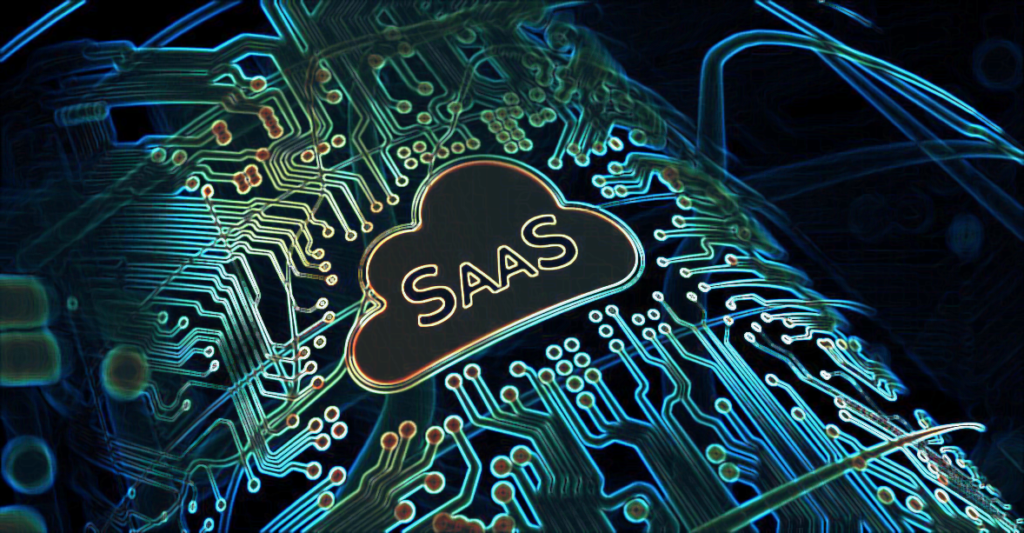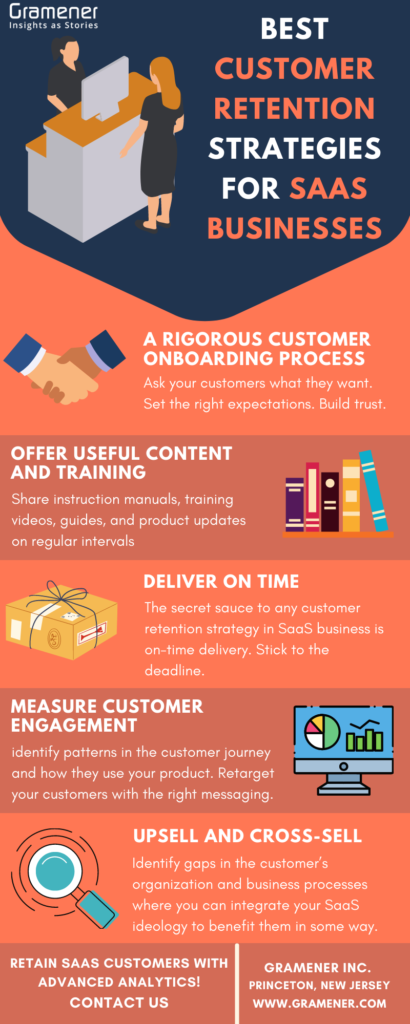Customer retention is challenging for SaaS (Software as a Service) founders. Customer churn is inevitable and investing in optimized SaaS retention strategies turns out to be crucial. In this article, we’ll share some of the best Saas customer retention strategies with Gramener’s SaaS-specific and low-code subscription-based model.
Table of Contents
Why We love SaaS: It’s Charmingly Customer-Centric
The SaaS business model has seen two decades in the software market and has experienced rapid growth. The first use of the term to describe software on-demand dates back to 2001. To date, this remains the largest market segment with a size of over $100 billion in 2020, Gartner estimates.
SaaS differs from traditional software offerings in multiple ways. It has shifted the balance of power to the customer. It has put pressure on the product to be easy to use and customer-responsive. And yet, competitive market and regular churn enable some of the best customer retention strategies to come out in the SaaS world.
The customer-centricity of SaaS is a natural fit for Gramener’s churn analysis approach to delight customers and retain them. It serves as the catalyst for the creation of our SaaS-specific lens.
Stages of a Typical SaaS Customer Journey
Stage 1: Acquisition to Gain Customers
Most SaaS go-to-market strategies accelerate customer acquisition by drastically reducing sales friction. It significantly shortens the sales cycle and minimizes customer objections.
- Try before you buy: The most common acquisition path in SaaS is to generate a qualified customer lead and drive it to the free trial of the software. If done well, it answers most of the questions customers have about how the software works and whether it’s the right solution.
- Low upfront investment: SaaS models make it easy for customers to start the process by minimizing the initial costs and/or spreading them over time.
- Low Total Cost of Ownership (TCO): Most of the SaaS offerings are hosted on the cloud. It removes the burden on the customer to have on-site hardware, perform updates and conduct maintenance. The IT/Operations team becomes less of a factor in the purchase decision.
Stage 2: Fulfillment to Serve Customers
Different from traditional software, fulfillment happens every day, week, and month in SaaS. As a result, most SaaS companies are building customer success organizations finely tuned to the customer’s experience while using the software.
- Onboarding replaces implementation: The removal of friction in the sales process means customers can get started quickly. Their initial experience of value after the purchase has a tremendous impact on customer satisfaction and success. Thus, the internal on-boarding function, and emphasis on successful on-boarding, prevails in SaaS.
- Subscription business model: Customers vote every time they renew. In the forefront of their mind is the question: “What have you done for me lately?” SaaS companies strive to remind customers of the value they are getting from the software. Forms of gamification are emerging as a light-hearted way to keep the value that customers receive on top of the mind.
- Know your customer better: For customer experience managers and data science practitioners, access to customer usage data is a dream come true. From behind the scenes, we can examine usage patterns, identify breakages, and build profiles of successful vs. unsuccessful customers.
Stage 3: Renewal to Retain Customers
This stage forces founders and CX managers to brainstorm about how to improve customer retention. In the SaaS model, customer retention becomes the most important metric to watch after acquisition/growth rate. Forecasting and operationalizing renewals require a firm grasp of customer experience.
It includes each and every touchpoint that is now influencing the customer’s decision to renew. The importance of renewals leads to certain teams/functions gaining more emphasis in SaaS companies.
- Account Management: Traditional AM functions have emphasized managing customer relationships. However, SaaS AM hires require a combination of relationship management, customer experience intuition, and the ability to leverage data to make decisions.
- Customer Experience: The customer journey, and breakdowns in the customer journey, tie directly to renewals. Hence, SaaS companies are getting more disciplined and investing more into a deep understanding of the customer journey.
- Big Data/Analytics: The overwhelming quantity of the customer data such as demo/firmographics, preferences, usage frequency and patterns, takes renewals from an art to a science. Predictive models tied to customer success and renewals are entirely possible in SaaS.
Some of the Best SaaS Customer Retention Strategies
A Better Customer Onboarding Process
Many SaaS Customer retention strategies begin as soon as they acquire customers. The first block of any customer retention strategy is to understand what customers want. Why? Because you want them not just for a one-year contract. You want them to engage for years and give you business. A planned customer onboarding process would allow you to gather data about customer expectations.
Offer Useful Content and Training
Along with selling software, SaaS companies also provide effective manuals to use them. Create SaaS-friendly content such as instruction manuals, guides, videos exhibiting the features of the software, or monthly email newsletters showcasing software upgrades. Build a team to give real-time product training to your customers. Walk them through each and every aspect of your product. You becoming part of customer learning gives a personalized experience to your customer. This keeps you close to the customer and shares a sense of loyalty.
Deliver on time
Yes! The secret sauce to any customer retention strategy in the SaaS business is on-time delivery. Stick to the deadline. A properly planned project timeline is one of the things that would add value to your customers. Maintain a regular interaction schedule with your customer to exchange notes on progress. Business transactions run on trust and you need to earn your customers’ trust with dedicated interactions and on-time delivery.
Monitor and Measure Customer Engagement
Customer engagement data hides tonnes of insights. You can identify patterns in the customer journey and how they use your product. You would understand what product features do they use the most. Custom-build customer experience data applications catch the behavior of customers that exhibit churn so you can stay a step ahead and retarget your customers with the right messaging.
Upsell and Cross-sell
Maintaining long-term relationships with existing customers is one of the best customer retention strategies. Identify gaps in the customer’s organization and business processes where you can integrate your SaaS ideology to benefit them in some way. Helping customers to resolve multiple pain points at a time is a great way to show your commitment to customer relationships.
Do Customer Survey and Take Feedback
Taking customer feedback is the first step to identifying loopholes in your product and service. With the help of customer sentiment analysis method, it is possible to determine whether or not your customers are satisfied with the products and services offered. It allows you to understand what went wrong, which resulted in customer churn. Design a customer survey with closed-end and open-ended questions. Exit surveys will give you enormous insights. Although there is a slight chance that the customer giving you the feedback might stay. However, the insights will help you increase customer retention in the future.
Build Customer Retention Strategies With SaaS-Based Approach
In the SaaS model, the Account Manager doesn’t need to wait or be surprised by a customer requesting to cancel. Teams may get a well-informed view of the customer’s engagement with the product much before the cancelation thought comes into the customer’s mind.
At Gramener, we help clients build strategies backed with data and focus on the few metrics which any company should, to improve customer retention in the SaaS business.
- Customer health score – current and future trend
- Onboarding satisfaction score (CSAT) within 90 days of joining and trends thereafter
- Customer Product Usage – No. of logins and trends, customer support inquiries, no. of subscriptions added/ removed
- Customer Service – First Call Resolution (FCR), Time to respond to emails
- Overall customer satisfaction/Net Promoter Score (NPS) by role – Decision-maker vs End-user
Below are a few customer retention industry benchmarks that any SaaS company should be aware of.
- Customer renewal rate is 80-85% in B2B space
- Trial period conversion, B2B space, across industries is 15-20%
- Customers retained after requesting cancelations is 10-15%
- The average discount offered for customer retention is 5-15%
- Indication to cancel if average login sessions are less than 6 in a month
SaaS Customer Retention With Our Subscription-Based Model
We leverage our CX experts to better understand the customers’ journey.
- First, our analytics team prioritizes which breakdowns we should address first. We create a customer 360 view followed by a detailed analysis that helps us come up with a clear prioritization and investment plan.
- Next, we drill down into the top retention priorities. We identify actions to take and processes that would impact the improvement in customer retention. For example, if on-boarding emerged as a high priority improvement area, a customer-centric quick-win could be to “Redesign the Onboarding Process” with a goal of shortening the timeframe for successful onboarding from 6 weeks to 2 weeks. We can see improvements from this phase of work in as early as 90 days.
- Then, we create the longer-term “operating plan to drive and improve customer retention” to an optimal level. We identify and prioritize the journeys we will improve, and the target metrics for improvement. Furthermore, we create scorecards to keep a pulse check on the progress and deliver insights via role-based dashboards. The Sustainable Programs most often take 12 months to execute, with clear progress each quarter.
Gramener has been helping SaaS-based companies in improving their customers’ experience with customized NPS Analytics solutions. We work for many Fortune 500 companies to build custom CX solutions. Team Gramener will help you in defining the CX needs based on your company’s CX maturity and handhold you through the process. For more information, contact Amit Garg at amit.garg@gramener.com.




